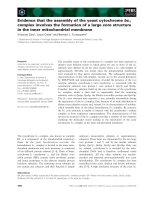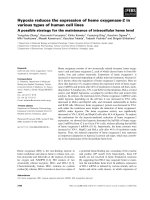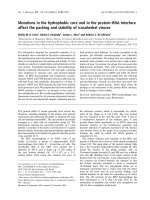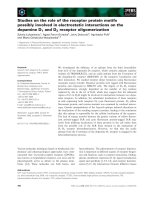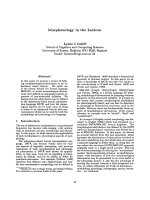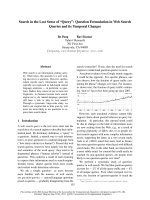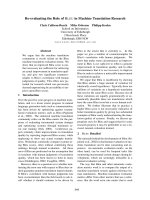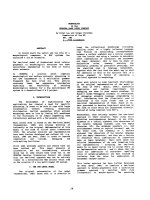Báo cáo khoa học: "Variation in the phenology of shoot elongation between geographic provenances of maritime pine (Pinus pinaster) - implications for the synchrony with the phenology of the twisting rust fungus" potx
Bạn đang xem bản rút gọn của tài liệu. Xem và tải ngay bản đầy đủ của tài liệu tại đây (1.13 MB, 16 trang )
Original
article
Variation
in
the
phenology
of
shoot
elongation
between
geographic
provenances
of
maritime
pine
(Pinus
pinaster) -
implications
for
the
synchrony
with
the
phenology
of
the
twisting
rust
fungus,
Melampsora
pinitorqua
ML
Desprez-Loustau,
F
Dupuis
INRA,
Centre
de
Bordeaux,
Station
de
Pathologie
Végétale,
BP 81,
F-33883
Villenave-d’Ornon
cedex,
France
(Received
18
March
1993;
accepted
17
December
1993)
Summary —
The
phenology
of
shoot
elongation
was
monitored
for
2
or
3
years
at
4
sites
in
France
with
6
maritime
pine
geographic
provenances.
Within
each
provenance,
the
onset
of
phenological
stages,
especially
the
earlier
ones,
was
better
predicted
by
heat
sums
than
by
calendar
days.
The
accuracy
of
prediction
could
be
increased
by
about
50%
for
the
earliest
studied
stage
(from
19
to
10
d).
However,
temporal
and,
to
a
greater
extent,
site
effects
were
still
observed
for
heat
sums.
These
may
be
attributed
in
part
to
stressful
environmental
conditions
for
pine.
The
geographic
provenances
used
represent
a
range
of
significantly
different
heat
requirements,
the
Tamjout
(from
Morocco)
and
the
Leiria
(from
Portugal)
provenances
representing
the
earliest
and
the
latest,
respectively,
with
a
difference
of
approximately
100
degree-days
(for
a
threshold
temperature
of
0°C).
A
positive
correlation
was
observed
between
precocity
and
vigour
though
this
could
not
explain
differences
in
precocity
between
provenances.
A
comparison
of
pine
and
rust
(Melampsora
pinitorqua)
phenologies,
monitored
at
the
same
sites
in
south-west
France,
revealed
that
synchrony
between
the
host-susceptible
stages
and
the
parasite-spore-producing
stages
did
not
always
occur.
The
earliness
of
the
Tamjout
provenance
pre-
disposed
it
to
greater
rust
infection
than
other
provenances
due
to
better
synchrony
with
basidiospore
production.
Variations
in
host-parasite
synchrony
are
discussed
from
an
evolutionary
perspective
and
in
relation
to
the
prediction
of
infection
risk.
maritime
pine
/
rust
/
phenology
/
susceptibility
period
/
infection
risk
Résumé —
Variabilité
phénologique
de
l’élongation
des
pousses
entre
provenances
géogra-
phiques
de
pin
maritime.
Conséquences
sur
la
synchronisation
avec
la
phénologie
du
cham-
pignon
responsable
de
la
rouille
courbeuse,
Melampsora
pinitorqua.
La
phénologie
d’élonga-
tion
des
pousses
a
été
suivie
pendant
2
ou
3
ans
dans
4
sites
pour
6
provenances
géographiques
de
pin
maritime.
Pour chaque
provenance,
les
sommes
de
températures
et
les
dates
ont
été
comparées
en
tant
que
variables
prédictrices
de
l’apparition
des
stades
phénologiques,
par
la
méthode
du
coef-
ficient
de
variation
et
de
l’erreur
standard
de
prédiction.
Les
sommes
de
températures
se
sont
révélées
les
meilleures
variables
prédictrices,
surtout pour
le
stade
le
plus
précoce,
avec une
erreur
de
prédiction
réduite
d’environ
50%
(de
19
à
10 j).
Toutefois,
il
reste
une
variation
entre
années
et
surtout
entre
sites.
Cette
dernière
pourrait
provenir
en
partie
de
conditions
défavorables
pour
la
croissance
des
pins
dans
2
des
sites
étudiés.
Les
provenances
étudiées
ont
manifesté
des
exigences
thermiques
significativement
différentes,
les
provenances
Tamjout
(Maroc)
et
Leiria
(Portugal)
représentant
la
plus
précoce
et
la
plus
tardive
respectivement,
avec
une
différence
d’environ
100
degrés/jours
(pour
un
seuil
de
0°C).
La
précocité
et
la
vigueur
sont
corrélées
positivement.
Toutefois
les
différences
de
précocité
entre
provenances
sont
maintenues
après
ajustement
à
la
vigueur.
La
sensibilité
des
pins
et
la
phénologie
du
champignon
responsable
de
la
rouille
courbeuse
(Melampsora
pinitorqua)
ont
été
sui-
vies
dans
le
même
site
dans
les
Landes.
La
coincidence
entre
les
stades
sensibles
chez
les
pins
et
la
production
de
basidiospores
par
le
champignon
n’est pas
toujours
observée,
même
pour
la
prove-
nance
landaise
de
pin
maritime.
La
précocité
de
la
provenance
Tamjout
se
traduit par
une
plus
grande
prédisposition
aux
infections
que
pour
les
autres
provenances,
du
fait
de
la
coincidence
entre
la
période
de
sensibilité
et la
production
de
basidiospores.
Une
discussion
est
proposée
sur les
variations
de
la
coincidence
phénologique
hôte-parasite,
du
point
de
vue
de
l’évolution
et
en
relation
avec
la
pré-
vision
des
risques
d’infection.
pin
maritime
/ rouille
/ phénologie
/ période
de
sensibilité
/ risque
d’infection
INTRODUCTION
Maritime
pine
(Pinus
pinaster
Ait)
shoot
elongation
has
been
studied
extensively
with
respect
to
seasonal
pattern
(Illy
and
Castaing,
1968),
genetic
control
(Kremer,
1982),
and
morphogenetic
components
(Kremer
and
Roussel,
1982, 1986;
Kremer
and
Lascoux,
1987).
However,
most
studies
have
focussed
on
quantitative
aspects
since
they
have
concerned
breeding
for
higher
growth
rates.
The
phenology
of
elongation
has
been
given
little
attention
as
it
often
appears
unrelated
to
total
shoot
growth
(Cannell
et al,
1976).
Our
interest
in
phenological
variation
in
maritime
pine
originates
from
an
observa-
tion
that
such
variation
appeared
to
be
asso-
ciated
with
differences
in
susceptibility
to
twisting
rust,
caused
by
Melampsora
pini-
torqua
Rostr
(Desprez-Loustau
and
Bara-
dat,
1991
). Pine
shoots
show
different
degrees
of
susceptibility
to
M
pinitorqua
according
to
their
elongation
stage,
the
maxi-
mum
susceptibility
being
observed
between
bud-scale
disjunction
and
needle
emergence
(Kurkela,
1973;
Desprez-Loustau,
1990).
Furthermore,
the
basidiospores
causing
infections
are
produced
only
for
a
short
period
in
spring
(approximately
1
month),
after
the
breaking
of
teliospore
dormancy
(Kurkela,
1973;
Desprez-Loustau
and
Dupuis,
1992).
Therefore,
variations
in
pine
phenology
may
affect
the
synchrony
between
susceptible
stages
and
basid-
iospore
occurrence.
The
prediction
of
phe-
nological
stages
in
maritime
pine
may
pro-
vide
a
risk
assessment
of
rust
infection,
when
related
to
the
prediction
of
basidiospore
dis-
persal.
The
present
study
was
undertaken
with
2
objectives.
The
first
was
to
confirm
and
define
the
extent
of
phenological
variation
in
maritime
pine:
our
previous
data
(Desprez-
Loustau
and
Baradat,
1991)
were
limited
to
a
few
measurements
at
a
single
site.
We
thus
compared
provenances
originating
from
the
whole
natural
distribution
area
of
P
pinasterat
4
locations
in
France
represent-
ing
a
wide
range
of
environmental
condi-
tions.
As
air
temperature
has
been
shown
to
be
a
major
determinant
of
shoot
growth
in
many
species
including
conifers
(Lavender,
1980;
Perala,
1985),
we
analysed
thermal
requirements
at
the
onset
of
the
different
phenological
stages
for
each
maritime
pine
provenance.
Pines
were
monitored
from
3
to
5
years
old,
at
an
age
of
fixed
growth
pattern
(ie
elongation
of
preformed
units,
Lanner,
1976)
and
with
a
high
susceptibility
to
twist-
ing
rust.
The
second
objective
was
to
give
further
biological
support
to
the
previously
observed
relationship
between
phenology
and
rust
infections
in
maritime
pine.
This
part
of
the
study
was
restricted
to
1
site
in
the
Landes
area,
where
the
fungus
has
a
natural
occurrence
and
the
pine
twisting
rust
disease
is
endemic. Rust
phenology
and
rust
susceptibility
of
3
contrasting
maritime
pine
provenances
were
monitored.
MATERIALS
AND
METHODS
Experimental
design
Six
geographic
provenances
of
P pinaster were
compared.
The
main
ecological
characteristics
of
the
seed
collection
sites
are
given
in
table
I.
In
additon,
’hybrids’
were
created
between
the
Landes
and
the
Corsica
provenances
by
pollina-
tion
of
5
maternal
trees
from
1
provenance
with
the
combined
pollen
from
10
paternal
trees
of
the
other.
Reciprocal
crossings
were
made
by
in-
versing
maternal
and
paternal
trees.
All
families
obtained
from
the
various
crossings
were
used
as
[Corsica
x
Landes]
hybrids.
Seedlings
were
grown
in
nursery
for
1
year,
and
then
transplanted
in
the
experimental
sites.
The
general
features
of
the
4
experimental
sites
are
given
in
table
II.
Sixty
plants
per
popula-
tion
(provenances
or
hybrids)
were
used
at
each
site.
The
[Corsica
x
Landes]
hybrids
were
not
used
at
the
Lagnereau
site.
Completely
randomized
designs
with
unit
plots
of
3-6
trees
were
used.
Monitoring
shoot
elongation
Weekly
observations
were
performed
in
spring
(March-June)
for
2
successive
years
at
each
site
(3
years
at
the
Ruscas
site).
On
each
observa-
tion
date,
shoot
length
and
phenological
stage
were
recorded
for
each
tree
on
the
leader
shoot.
The
phenological
stages
were
defined
according
to
Debazac
(1966)
(fig
1),
as follows:
B0:
dormant
buds;
B1:
buds
swollen;
B2:
buds
elongating,
disjunction
of
bud
scales
making
the
shoot
surface
visible;
B3:
emergence
of
brachyblasts;
B4:
emergence
of
needles;
B5:
disjunction
of
the
needles
from
the
same
fas-
cicle
Owing
to
the
acropetal
development
of
shoots,
observations
were
made
at
approximately
the
U3
level
from
the
shoot
base;
L
is
defined
as
the
shoot
length
on
the
observation
date.
The
date
of
occur-
rence
of
a
phenological
stage
was
considered
to
be
the
date
when
this
stage
was
first
observed.
Phenology
of
M
pinitorqua
Samples
of
infected
aspen
leaves,
the
over-
wintering
host
of
M pinitorqua,
were
collected
on
each
observation
date
near
the
Lagnereau
and
Ruscas
sites
in
1989
and
1990.
The
develop-
mental
stage
of
the
fungus
was
defined
as
its
potential
to
produce
basidiospores
under
optimal
conditions
in
the
laboratory,
as
described
previ-
ously
(Desprez-Loustau
and
Dupuis,
1992).
The
period
extending
from
maximum
production
to
the
end
of
production
under
these
conditions
was
shown
to
coincide
with
basidiospore
dispersal
under
field
conditions.
Shoot
susceptibility
tests
Shoots
from
the
last
whorl
level
were
collected
from
3
provenances
(Landes,
Tamjout
and
Vivario)
on
5
dates
in
1989
and
1990
at
the
Lagnereau
experimental
site.
Inoculations
were
performed
on
excised
shoots
under
controlled
conditions,
using
basidiospore
producing
aspen
leaf
discs,
as
described
previously
(Desprez-Lous-
tau,
1990).
Mean
basidiospore
numbers
per
inoc-
ulated
shoots
were
approximately
10
000
(350
per
mm
2)
in
1989
and
5
000
(180
per
mm
2)
in
1990.
Successful
inoculations
(ie
shoots
bearing
pycnia
and/or
aecia)
were
assessed
after
3
weeks.
Meteorological
data
Minimum
and
maximum
daily
temperatures
recorded
at
the
nearest
standard
climatological
station
(National
Meteorological
Network)
were
used
for
each
site.
Heat
sums
(HS),
in
degree-
days,
were
calculated
according
to
the
following
formula:
for
days
with
Tm
i
> Tt;
Tm
i=
mean
daily
temper-
ature,
calculated
as
Tm
=
(Tmin
+
Tmax)/2
or
assuming
a
sinewave
diurnal
fluctuation
between
Tmin and
Tmax;
Tt=
threshold
temperature.
Each
degree
from
0
to
5°C
was
tested,
as
this
range
includes
values
commonly
used
for
shoot
growth
studies
(Cannell
and
Smith,
1983;
Osawa
et al,
1983;
Perala,
1985;
Volney
and
Cerezke,
1992).
cummulative
degree-day
values
were
always
calculated
from
January
1
of
each
year.
Statistical
analysis
Calendar
days
and
the
different
heat
sums,
obtained
with
the
aforementioned
formula,
were
compared
as
predictors
of
the
onset
of
pheno-
logical
stages.
Two
statistical
approaches,
the
coefficient
of
variation
and
the
standard
error
of
prediction
were
used
(Castonguay
et al,
1984).
First,
the
mean
of
individual
tree
values
was
cal-
culated
for the
different tested
variables
in
each
of
the
9
[site
x
year]
combinations
of
the
study,
for
each
stage
and
each
provenance.
The
coefficients
of
variation
(CV),
ie
the
ratio
of
the
mean
to
the
standard
deviation
of
these
9
values,
were
then
calculated.
The
approach
using
the
standard
error
of
prediction
is
based
on
the
comparison
between
observed
and
predicted
dates
of
the
onset
of
phenological
stages.
Predicted
dates
were
obtained
as
follows.
For
calendar
days,
the
pre-
dicted
value,
taken
for
1
given
provenance
and
1
given
stage,
was
the
mean
date
observed
over
the
9
[site
x
year]
combinations.
For
heat
sum
variables,
the
predicted
dates
were
obtained
by
determining,
in
each
of
the
9
[site
x
year]
combi-
nations
the
date
corresponding
to
the
mean
heat
sum
value
previously
calculated
from
the
9
observed
values
from
their
respective
meteoro-
logical
data.
The
error
of
prediction
was
calcu-
lated
as
the
difference
between
the
predicted
and
actual
dates.
The
mean
value
of
these
errors
over
the
9
[site
x
year]
combinations
should
be
null.
The
standard
deviation
represents
the
standard
error
of
prediction
(Castonguay
et al,
1984).
The
best
predictor
variables
should
present
low
val-
ues
of
both
coefficient
of
variation
and
the
standard
error
of
prediction.
Phenological
data
were
analysed
by
analysis
of
variance
with
the
SAS
package
(SAS
Institute,
1988).
Means
per
unit
plot,
comprising
3-6
trees,
were
considered
as
elementary
data.
As
the
same
trees
were
observed
in
the
successive
years
(resulting
in
an
inherent
correlation
of
measure-
ments
between
years),
repeated
measures
anal-
ysis
of
variance
were
performed,
using
a
multi-
variate
approach
(Moser
et
al,
1990).
The
non-violation
of
the
assumptions
of
the
analysis
of
variance,
particularly
the
adequacy
of
the
model
and
the
homogeneity
of
residual
variances,
were
checked
graphically
by
plotting
residuals
against
predicted
values
and
examining
the
distribution
of
intra-group
variances.
Infection
percentages
were
analysed
using
a
generalization
of
the
analysis
of
variance
adapted
to
categorical
data
analysis
(CATMOD
procedure
of
SAS).
A
log-linear
model,
with
a
maximum-
likelihood
estimation
of
the
parameters,
was
used.
RESULTS
Pine
phenology
The
mean
dates
of
occurrence,
all
prove-
nances
being
pooled,
of
the
different
phe-
nological
stages
for
the
9
[site
x
year]
com-
binations
are
given
in
table
III.
The
phenological
evolution
of
the
Landes
prove-
nance
at
the
Lagnereau
site
in
1989
and
1990
is
presented
in
figure
2
as
an
example.
A
range
of
about
40
d
was
observed
between
sites
for
the
same
stage.
As
expected,
pine
development
occurred
much
later
in
the
northern
site
(Orleans)
than
in
the
3
southern
ones.
Variation
within
any
given
site
over
the
2-
to
3-year
observation
period
was
less
than
between
sites.
Results
on
coefficients
of
variation
and
standard
errors
of
prediction
of
the
differ-
ent
variables
tested
as
predictors
of
phe-
nological
stages
are
presented
in
figure
3.
As
similar
trends
were
observed
for
all
provenances,
only
mean
values
are
pre-
sented.
In
preliminary
calculations,
CV val-
ues
using
the
sine
curve
reconstitution
of
daily
temperatures
were
slightly
higher
than
those
obtained
with
the
simpler
formula
Tm
=
(Tmin
+
Tmax)/2.
The
latter
formula
was
therefore
used
for
the threshold
study.
For
the
B2
stage,
heat
sums
always
pre-
sented
a
lower
CV than
calendar
days.
For
all
stages,
a
regular
decreasing
trend
of
CV
was
observed
for
threshold
values
de-
creasing
from
5
to
0°C.
The
heat
sum
cal-
culated
with
a
threshold
value
of
0°C
gave
a
lower
CV than
calendar
days
for
all
stages,
except
B5.
Standard
errors
of
prediction
cal-
culated
for
heat
sums
(with
Tm
=
(Tmin
+
Tmax)/2)
were
always
much
lower
than
for
calendar
days,
the
difference
being
maxi-
mum
for
the
B2
stage
(about
9
d).
Very
little
variation
was
observed
in
relation
to
thresh-
old
temperature
values.
From
the
above
results,
the
heat
sum
calculated
with
Tm
=
(Tmin
+
Tmax)/2
and
with
a
threshold
value
of
0°C
was
chosen
as
the
best
predictive
variable
for
the
onset
of
phenological
stages
and
used
for
further
analysis
(expressed
in
degree-days
above
0°C
=
DD
0
).
The
heat
sum
means
at
the
onset
of
the
different
stages
for
the
4
sites,
all
prove-
nances
being
pooled,
are
presented
in
table
IV.
HS
values
per
tree
(all
provenances
and
sites
pooled
together)
reached
at
2
different
phenological
stages
within
the
same
year
were
highly
significantly
correlated
(r=
0.61
to
0.92,
according
to
stage
and
year).
Variation
in
phenology
between
maritime
pine
provenances
An
analysis
of
variance
with
HS
as
the
dependent
variable
was
performed
for
each
phenological
stage.
A
general
model
with
site,
provenance
(6
levels
corresponding
to
the
6
geographic
provenances),
time
(2
levels
corresponding
to
the
third
and
fourth
year
after
plantation)
and
interaction
effects
was
first
tested.
Adjusted
sums
of
squares
(type
III
of
SAS)
were
used
owing
to
the
dif-
ferent
numbers
of
unit
plots
at
the
4
sites.
These
results
are
given
in
table
V.
For
all
phenological
stages,
provenance,
site
[provenance
x
site]
and
[time
x
site]
effects
were
significant
at
the
5%
level.
HS values
at
the
onset
of
the
different
phenological
stages
were
always
significantly
lower
at
the
Truncat
and
Orleans
sites
than
at
the
Lagnereau
and
Ruscas
sites
(interactions
with
time
or
provenance
did
not
affect
this
major
distinction).
A
significant
effect
of
time
appeared
only
at
the
B3
and
B4
stages
with
either
no
interaction
or
only
a
slightly
sig-
nificant
interaction
with
provenance.
No
def-
inite
trend
was
observed
between
succes-
sive
years.
Owing
to
the
significant
[provenance
x
site]
effect,
and
also
to
include
[Corsica
x
hybrids,
an
analysis
of
variance
was
then
performed
for
each
site
with
a
restricted
model
without
site
and
[site
x
other
sources]
effects.
A
significant
provenance
effect
was
observed
in
22
out
of
the
36
[site
x
year
x
stage]
analyses
(table
VI).
A
few
[year
x
site]
combinations
did
not
allow
a
discrimination
between
provenances,
mainly
in
1990
at
the
Truncat
site
and
in
1991
at
the
Orleans
site.
In
most
cases
with
a
provenance
effect
(19
out
of
22),
the
Tamjout
provenance
exhibited
a
significantly
higher
precocity
(ie
lower
heat
sum
values)
than
the
Leiria
provenance,
the
other
prove-
nances
being
intermediate
(same
results
obtained
with
Student
Newman
Keuls,
Scheffe’s
and
Tukey’s
tests).
The
[Corsica
x
Landes]
hybrid
always
fell
within
the
same
homogeneous
group
as
its
parent
popula-
tions.
In
order
to
generate
data
for
all
sites,
years
and
stages,
the
provenance
means
(in
DD
0)
for
each
analysis
were
replaced
by
the
difference
with
the
overall
mean
for
all
provenances.
The
mean
of
these
deviations
was
then
calculated
for
each
provenance
(cf table
VII).
The
earliness
of
the
Tamjout
provenance
was
clearly
indicated
by
a
large
negative
deviation
in
DD
0
from
the
mean
of
provenances.
The
Leiria
provenance
exhib-
ited
a
contrasting
behaviour
with
a
delay
of
about
100
DD
0
as
compared
to
Tamjout.
Other
provenances
showed
an
intermedi-
ate
behaviour.
The
[Corsica
x
Landes]
hybrid
appeared
to
show
lower
heat
require-
ments,
on
average,
than
its
2
parent
popu-
lations.
Relation
between
phenology
and
shoot
elongation
For
all
pairs
of
shoot
length
measurements
on
a
single
tree,
at
2
different
dates
within
the
same
year,
highly
significant
correla-
tions
were
observed
(r=
0.6-0.99).
The
last
measurement
of
length
(when
most
pines
had
reached
the
B5
stage)
was
considered
further
for
the
study
of
the
relations
between
phenology
and
shoot
growth.
It
was
shown
to
be
highly
correlated
with
tree
height
(r=
0.73
and
0.67
for
1989
and
1990,
respec-
tively)
at
the
Ruscas
site,
where
these
data
were
available.
A
significant
effect
of
provenance
for
shoot
length
was
observed
only
at
the
Lagnereau
site
(results
not
shown),
the
Leiria
provenance
presented
the
lowest
growth
for
both
years.
Significant
differences
between
sites
were
apparent,
pines
in
the
Truncat
and
Orleans
sites
showing
poor
growth
(approximately
10
cm
for
the
last
measure
of
shoot
length
for
both
years)
compared
with
the
Lagnereau
site
(approx-
imately
20
cm)
and
more
so
the
Ruscas
(30-50
cm)
site.
Within
each
site,
the
HS accumulated
at
each
phenological
stage
were
negatively
correlated
with
shoot
length
for
the
same
year,
ie
the
more
vigorous
trees
had
an
ear-
lier
development
(table
VIII).
Similar
trends
were
observed
for
each
provenance
in
the
Lagnereau
and
Ruscas
experiments
and
more
variation
between
provenances
was
observed
in
the
Orleans
and
Truncat
experi-
ments.
An
analysis
of
covariance
was
thus
performed
for
the
first
2
sites,
for
each
phe-
nological
stage,
with
HS as
the
dependent
variable,
provenance
as
the
independent
variable
and
shoot
length
as
the
covariable.
Provenance
effects
observed
in
the
analysis
of
variance
(table
VI)
were
always
main-
tained
after
adjustment
with
the
covariable.
Tamjout
and
Leiria
remained
the
earliest
and
latest
provenances,
respectively.
Rank-
ings
of
intermediate
provenances
were
weakly
affected.
Rust
phenology -
variation
in
the
timing
of
susceptibility
between
3
provenances
at
the
Lagnereau
site
Periods
of
potential
basidiospore
dispersal
(ie
from
the
date
of
maximum
production
to
the
date
of
the
end
of
production
under
opti-
mal
conditions)
occurred
throughout
April
for
both
years
and
sites:
April
4-17,
1989
and
April
5-23,
1990
at
the
Truncat
site;
April
4-24,
1989
and
April
5-23,
1990
at
the
Lagnereau
site.
The
evolution
of
susceptibility,
expressed
as
infection
percentage
after
artificial
inoc-
ulation,
of
the
Corsican,
Moroccan
and
Landes
provenances
for
spring
1989
and
1990
is
presented
in
figure
4,
where
poten-
tial
basidiospore
dispersal
is
also
shown.
Only
the
Moroccan
provenance
in
1989
appeared
to
show
a
significant
degree
of
susceptibility
before
the
end
of
the
basid-
iospore
production
period.
For
both
years,
the
3
provenances
did
not
differ
significantly
in
their
overall
susceptibility
throughout
(table
IX).
However,
the
significant
[provenance
x
date]
effect
in
1989
indicated
a
difference
in
the
timing
of
susceptibility
between
the
3
provenances.
This
was
mainly
due
to
the
earlier
receptivity
of
the
Moroccan
provenance
compared
with
the
other
2
provenances.
Differences
in
infection
percentages
were
highly
significant
in
1989
for
the
2
first
observation
dates,
though
this
was
not
the
case
in
1990.
DISCUSSION
Our
results
have
defined
the
phenological
development
of
maritime
pine.
In
agreement
with
previous
work
on
other
species
(Per-
ala,
1985;
Ramesh
and
Gopalaswamy,
1991),
air
temperature
degree-days
were
shown
to
have
a
better
predictive
value
of
the
onset
of
phenological
stages,
particu-
larly
the
earlier
ones,
than
calendar
days.
The
accuracy
of
prediction
was
increased
by
approximately
50%
for
the
B2
stage,
from
19
d,
with
calendar
days
as
predictor,
to
10
d,
with
HS.
This
is
most
interesting
from
an
epidemiological
point
of
view
as
the
B2
stage
corresponds
to
the
beginning
of
pine
susceptibility
to
twisting
rust
(Desprez-Lous-
tau,
1990).
The
lower
adequacy
of
HS
in
predicting
later
stages
may
be
partly
arte-
factual,
arising
from
an
increase
in
the
error
on
HS
calculations
with
time,
related
to
sea-
sonal
warming,
whereas
the
error
on
cal-
endar
days
remains
constant
(weekly
obser-
vations).
The
threshold
temperature
of
0°C
has
been
chosen
for
statistical
considera-
tions
though
its
biological
significance
is
unknown.
This
value
is
lower than
those
commonly
found
in
literature
concerning
pine
shoot
elongation
and
may
be
partly
related
to
the
fact
that
we
studied
earlier
stages
(Castonguay
et al,
1984).
However,
differences
were
still
observed
between
sites,
and
to
a
much
lesser
extent
between
years,
when
considering
HS
at
the
occurrence
of
phenological
stages.
This
could
account
for
factors
other
than
air
tem-
perature
which
have
not
been
included
in
the
model.
Soil
temperature
may
be
a
better
predictor
of
shoot
growth
than
air
temper-
ature
(Lavender,
1980).
Soil
water
poten-
tial
has
been
shown
to
be
a
contributing
fac-
tor
in
red
pine
shoot
growth
(Jones
et
al,
1991).
Site
effects
may
also
result
in
part
from
differences
in
the
accuracy
of
weather
station
data
in
reflecting
the
experimental
site
microclimate.
HS
for
the
Orleans
and
Truncat
sites
may
have
been
underesti-
mated
owing
to
their
particular
location
(ie
a
forest
clearing
in
the
former
and
a
coastal
dune
in
the
latter
case).
In
addition,
there
was
no
clearance
of
the
indigenous
vege-
tation
at
these
2
sites,
with
a
consequence
that
the
proliferation
of
blackberry
bushes
may
have
provided
shelter
for
the
pines.
Finally,
the
Orleans
and
Truncat
sites
appeared
to
be
inferior
sites
for
pine
growth,
probably
due
to
sub-optimal
soil
conditions,
possibly
combined
with
the
presence
of
blackberry
bushes
(competition
effects
for
nutrients
and/or
water).
The
interaction
of
water
stress
and
plant
phenology
has
been
emphasized
by
ldso
et al (1978).
Water
stress
has
been
shown
to
result
in
earlier
flushing
in
young
Cedrus
saplings
(Finkel-
stein,
1981).
Results
obtained
at
the
Lagnereau
and
Ruscas
sites
are
possibly
more
representative
of
the
average
behaviour
of
maritime
pine
under
silvicul-
tural
conditions.
With
a
view
to
predicting
the
phenological
stages,
the
aforementioned
factors
should
be
taken
into
account.
The
number
of
observation
years
employed
was
too
few
for
detecting
any
age
effect,
though
it
is
likely
that
this
effect
occurs,
as
men-
tioned
for
other
species
(Nienstaedt,
1974).
The
demonstration
of
a
variation
in
phe-
nology
between
maritime
pine
provenances
confirms
earlier
results
(Desprez-Loustau
and
Baradat,
1991).
The
Tamjout
prove-
nance
appears
to
require
significantly
lower
HS than
the
Leiria
provenance
to
complete
the
early
stages
of
growth.
Other
prove-
nances
were
found
to
be
intermediate,
but
might
have
been
better
discriminated
with
a
more
precise
notation
of
phenological
stages,
on
bi-weekly
basis
for
example.
This
study
also
confirms
that
the
precocity
of
the
inter-provenance
hybrid
is
greater
than
that
of
its
parent
populations.
The
provenance
effect
for
phenology
is
not
a
result
of
differ-
ences
in
vigour,
as
evidenced
by
the
covari-
ance
analysis.
However,
differences
between
provenances
were
less
often
observed
at
the
inferior
sites.
In
contrast
to
pine
phenological
data,
the
same
period
of
M
pinitorqua
basidiospore
production
was
observed
at
the
2
Landes
sites
and
for
the
2
years
of
observation,
sug-
gesting
that
pine
and
rust
phenologies
are
driven
by
different
factors.
This
resulted
in
a
variation
of
pine-rust
synchrony
between
sites
and
years.
At
the
Lagnereau
site,
for
both
years
of
observation,
shoot
elongation,
on
average
for
all
provenances,
took
place
when
basidiospores
were
no
longer
pro-
duced.
This
was
also
observed
for
the
local
(Landes)
provenance.
The
earlier
develop-
ment
of
the
Tamjout
provenance
resulted
in
a
higher
susceptibility
to
rust
than
the
other
provenances
at
the
time
when
basidio-
spores
were
still
being
released.
This
is
in
agreement
with
previous
data
from
another
Landes
site
where
the
higher
field
suscep-
tibility
of
the
Tamjout
provenance
was
though
to
be
due
to
its
higher
precocity
(Desprez-Loustau
and
Baradat,
1991).
The
observation
that
shoot
susceptibil-
ity
in
the
Landes
provenance
was
out
of
phase
with
the
basidiospore
production
period
in
the
same
area
for
the
2
years
of
the
study,
is
remarkable.
This
observation
is
in
agreement
with
most
of
our
data
for
the
Landes
area,
where
M
pinitorqua
basidio-
spores
are
often
produced
before
or
at
the
very
beginning
of
maritime
pine
shoot
sus-
ceptibility
(unpublished
results).
This
may
explain
the
very
irregular
pattern
of
rust
damage
in
the
area
between
years
and
sites.
The
’rust
explosions’
observed
in
some
years
may
be
the
result
of
a
good
synchrony
between
host
and
parasite
phenologies
due
to
particular
weather
conditions.
The
impor-
tance
of
pine
phenology
in
relation
to
M
pinotorqua
infection
has
also
been
empha-
sized
in
the
case
of
P
nigra
(Longo
et
al,
1970,
1980).
In
contrast
to
maritime
pine,
M pinitorqua
appears
better
adapted
to
the
P sylvestris host.
In
P
sylvestris,
annual
vari-
ations
in
infection
were
attributed
mainly
to
climatic
conditions
during
pine
growth;
syn-
chrony
between
host
and
parasite
phe-
nologies
is
generally
observed
(Kurkela,
1973).
As
previously
hypothesized
by
Moriondo
(1957)
considering
the
occurrence
of
M
pinitorqua
in
Italy,
this
fungus,
which
is
better
adapted
to
rather
cold
climates,
may
have
moved
from
northern
to
south-
ern
Europe
during
the
glaciary
and
post-
glaciary
periods,
in
association
with
P
sylvestris.
It
may
then
have
passed
to
other
susceptible
pine
species
such
as
P pinaster.
Indeed,
P
pinaster
is
thought
to
have
appeared
in
the
northern
Landes
area
approximately
8
000
years
ago,
at
a
time
when
P
sylvestris
was
the
dominant
species
(Baradat
and
Marpeau-Bezard,
1988).
The
presence
of
M pinitorqua
in
the
Landes
area
may
therefore
represent
a
relic
of
this
period,
which
may
explain
the
partial
lack
of
adap-
tation
to
present
climatic
conditions.
Syn-
chronization
of
the
M pinitorqua
life
cycle
with
that
of
pine
is
not
critical
for
the
sur-
vival
of
this
rust
as
it
can
maintain
itself
upon
the
telial
host
(ie
aspen).
Moreover,
pine
infection
can
occur
over
a
much
longer
period
on
seedlings
and
young
saplings,
with
a
free
growth
pattern,
which
are sus-
ceptible
during
all
the
growing
season.
Rust
synchronization
with
maritime
pine
phenol-
ogy,
therefore,
may
not
have
been
subjected
to
a
high
selection
pressure.
In
contrast
with
the
maritime
pine-rust
system,
a
good
syn-
chronization
between
host
and
parasite
phe-
nologies
has
been
reported
for
other
pine
rusts
(Merrill
and
Kistler,
1976;
Hollis
and
Schmidt,
1977),
which
may
reflect
a
longer
coevolution
process.
Synchronization
with
the host
plant
has
also
been
shown
to
be
critical,
and
of
great
evolutionary
signifi-
cance,
for
several
phytophagous
insects,
especially
those
which
feed
on
newly
emerged
foliage
(Du
Merle,
1983, 1988;
Hunter,
1992).
Overall,
this
study
has
emphasized
the
link
between
maritime
pine
phenology
and
predisposition
to
rust
infections.
1.
Annual
and
spatial
variations
in
rust
infec-
tion
on
maritime
pines
are
likely
to
result
mainly
from
differences
in
synchrony
between
host
and
parasite,
resulting
from
weather
(and
microclimatological)
condi-
tions.
Changes
in
climate,
such
as
warm-
ing,
may
affect
pine-rust
synchrony,
as
pre-
dicted
for
plant-insect
interactions
(Dewar
and
Watt,
1992).
Modelling
of
pine
and
rust
phenologies
with
respect
to
climatological
factors
is
essential
in
order
to
predict
spatio-
temporal
patterns
of
infection
risks.
2.
Differences
in
precocity
between
geno-
types
may
result
in
differences
in
predispo-
sition
to
infection.
Changes
in
vigour
(higher
growth)
may
also
affect
the
infection
risk
in
relation
to
higher
precocity.
This
factor
should
be
taken
into
account
in
maritime
pine
breeding.
Selection
for
higher
growth
has
been
shown
to
result
in
earlier
flushing
in
several
species
(Kleinschmit
and
Sauer,
1976;
Rehfeldt,
1992).
Fertilization
effects
should
also
be
considered.
ACKNOWLEDGMENTS
We
thank
the
technical
staff
of
INRA
Experimental
Stations
at
Le
Ruscas,
Orleans
and
Bordeaux,
especially
D
Vauthier,
M
Vallance
and
P
Paz-
tuzka,
for
their
technical
assistace;
H
Jactel
and
A
Kremer
for
their
helpful
comments
on
the
manuscript;
and
M
Guye
for
reviewing
the
English.
REFERENCES
Baradat
P,
Marpeau-Bezard
A
(1988)
Le
pin
maritime
Pinus
pinaster Ait.
Biologie
et
génétique
des
ter-
pènes
pour
la
connaissance
et
l’amélioration
de
l’e-
spèce. Thèse
d’Etat
de
l’Université
Bordeaux
I,
France
Cannell GR, Smith
RI
(1983)
Thermal
time, chill
days
and
prediction
of
budburst
in
Picea
sitchensis.
JAppl
Ecol 20, 951-963
Cannell
GR,
Thompson
S,
Lines
R
(1976)
An
analysis
of
inherent
differences
in
shoot
growth
within
some
north
temperate
conifers.
In:
Tree
Physiology
and
Yield
Improvement
(MGR
Cannell,
FT
Last,
eds)
Academic
Press,
New
York,
USA
Castonguay
Y,
Boisvert
J,
Dubé
PA
(1984)
Comparaison
de
techniques
statistiques
utilisées
dans
l’élaboration
de
modèles
prévisionnels
phénoclimatiques.
Agric
For
Meteorol 31,
273-288
Debazac
EF
(1966)
Les
modalités
de
la
croissance
en
hauteur
chez
les
pins.
Bull
Soc
Bot
Fr,
3-14
Desprez-Loustau
ML
(1990)
A
cut-shoot
bioassay
for
assessment
of
maritime
pine
susceptibility
to
twisting
rust.
Eur
J
For
Pathol 20,
386-391
Desprez-Loustau
ML,
Baradat
P
(1991)
Variabilité
inter-
raciale
de
la
sensibilité
à
la
rouille
courbeuse
chez
le
pin
maritime.
Ann
Sci
For 48,
497-511
Desprez-Loustau
ML,
Dupuis
F
(1992)
A
time-course
study
of
teliospore
germination
and
basidiospore
release
in
Melampsora
pinitorqua.
Mycol
Res
96,
442-446
Dewar
RC,
Watt
AD
(1992)
Predicted
changes
in
the
synchrony
of
larval
emergence
and
budburst
under
climatic
warming.
Oecologia
89, 557-559
Du
Merle
P
(1983)
Phénologies
comparées
du
chêne
pubescent,
du
chêne
vert
et
de
Tortrix
viridana
L
(Lep
Tortricidae).
Mise
en
evidence
chez
l’insecte
de
deux
populations
sympatriques
adaptées
cha-
cune
à
l’un
des
chênes.
Acta
Œcol
Œcol
Applic
4,
55-
74
Du
Merle
P
(1988)
Phenological
resistance
of
oaks
to
the
green
oak
leafroller,
Tortrix
viridana
L
(Lep
Tortrici-
dae).
In:
Mechanisms
of
Woody
Plant
Defenses
against
Insects -
Search
for
Pattern
(WJ
Mattson,
J
Levieux,
C
Bernard-Dagan,
eds)
Springer-Verlag,
New
York,
USA,
215-226
Finkelstein
D
(1981)
Influence
des
conditions
d’alimen-
tation
hydrique
sur
le
débourrement
et
la
croissance
des
jeunes
plants
de
Cèdre
(Cedrus
atlantica
Manetti)
cultivés
en
serre.
Ann
Sci
For 38,
513-530
Hollis
CA,
Schmidt
RA
(1977)
Site
factors
related
to
fusiform
rust
incidence
in
north
Florida
slash
pine
plantations.
For Sci 23,
69-77
Hunter
MD
(1992)
A
variable
plant-insect
interaction:
the
relationship
between
tree
budburst
phenology
and
population
levels
of
insect
herbivores
among
trees.
Ecol
Entomol 16,
91-95
Idso
SB,
Jackson
RD,
Reginato
RJ
(1978)
Extending
the
’degree
day’ concept
of
plant
phenological
devel-
opment
to
include
water
stress
effects.
Ecology 59,
431-433
Illy G,
Castaing
JP
(1968)
Rythme
saisonnier de
la crois-
sance
en
diamètre
et
en
hauteur
chez
le
pin
mar-
itime.
Bull
Soc
Bot
Fr
173-179
Jones
EA,
Reed
DD,
Cattelino
PJ,
Mroz
GD
(1991) Sea-
sonal
shoot
growth
of
planted
red
pine
predicted
from
air
temperature
degree
days
and
soil
water
potential.
For Ecol Manage
46, 201-214
Kleinschmit
J,
Sauer
A
(1976)
Variation
in
morphology,
phenology
and
nutrient
content
among
Picea
abies
clones
and
provenances,
and
its
implications
for
tree
improvement.
In:
Tree
Physiology
and
Yield
Improve-
ment (MGR
Cannell,
FT
Last,
eds)
Academic
Press,
New York,
503-517
Kremer
A
(1982)
Déterminisme
génétique
de
la
crois-
sance
en
hauteur
du
pin
maritime
(Pinus
pinaster
Ait).
1.
Rôle
du
polycyclisme.
Ann
Sci
For 38,
199-
222
Kremer
A,
Roussel
G
(1982)
Composantes
de
la
crois-
sance
en
hauteur
du
pin
maritime
(Pinus
pinaster
Ait).
Ann
Sci
For 39,
77-98
Kremer
A,
Roussel
G
(1986)
Décomposition
de
la
crois-
sance
en
hauteur
du
pin
maritime
(Pinus
pinaster
Ait).
Variabilité
géographique
des
composantes
mor-
phogénétiques
et
phénologiques.
Ann
Sci
For 43,
15-34
Kremer
A,
Lascoux
M
(1987)
Genetic
architecture
of
height
growth
in
maritime
pine.
Silvae
Genet 37,
1-
8
Kurkela
T
(1973)
Epiphytology
of
Melampsora
rusts
of
Scots
pine
(Pinus
sylvestris
L)
and
aspen
(Populus
tremula
L).
Comm
Inst
For
Fenn
79,
1-68
Lanner
(1976)
Patterns
of
shoot
development
in
Pinus
and
their
relationship
to
growth
potential.
In:
Tree
Physiology
and
Yield
Improvement
(MGR
Cannell,
FT
Last,
eds),
Academic
Press,
New
York,
USA,
503-517
Lavender
DP
(1980)
Effects
of
the
environment
upon
the
shoot
growth
of
woody
plants.
In:
Proc
IUFRO
Meeting
’Control
of shoot
growth
in
trees’,
July
20-24,
Fredericton,
Canada
(CHA
Little,
ed),
76-106
Longo
N,
Moriondo
F,
Naldini
BM
(1970)
Biologia
ed
epidemiologia
di
Melampsora
pinitorqua
Rostr.
Ann
Accad It Sc
For
XIX,
83-175
Longo
N,
Moriondo
F,
Naldini-Longo
BM
(1980)
Some
aspects
of
biology
of
Melampsora
pinitorqua
Rostr
in
Italy,
also
compared
to
other
European
countries.
Phytopath
Medit
19,
30-34
Merrill
W,
Kistler
BR
(1976)
Phenology
and
control
of
Endocronartium
harknesii
in
Pennsylvania.
Phy-
topathology 66,
1246-1248
Moriondo
F
(1957)
Osservazioni
sulla
diffusione
della
ruggine
curvatrice
del
pino
in
Italia.
La
Ricerca
Sci-
entifica
27,
405-411
Moser
EB,
Saxton
AM,
Pezeshki
SR
(1990)
Repeated
measures
analysis
of
variance:
application
to
tree
research.
Can
J
For
Res
20,
524-535
Nienstaedt
H
(1974)
Genetica
variation
in
some
phe-
nological
characteristics
of
forest
trees.
In:
Phenol-
ogy
and
Seasonality
Modelling
(H
Lieth,
ed)
Springer
Verlag, 389-400
Osawa
A,
Shoemaker
CA,
Stedinger
JR
(1983)
A
stochastic
model
of
balsam
fir
bud
phenology
utiliz-
ing
maximum
likelihood
parameter
estimation.
For
Sci
29, 478-490
Perala
DA
(1985)
Predicting
red
pine
shoot
growth
using
growing
degree
days.
For Sci 31,
913-625
Ramesh
P,
Gopalaswamy
N
(1991)
Heat
unit
require-
ment
and
prediction
of
developmental
stages
in
soy-
bean.
J
Agron
Crop
Sci
167, 236-240
Rehfeldt
GE
(1992)
Early
selection
in
Pinus ponderosa:
compromises
between
growth
potential
and
growth
rhythm
in
developing
breeding
strategies.
For
Sci
38, 661-677
SAS
Institute
Inc
(1988)
SAS/STAT
User’s
Guide.
Release
6.03
edition.
SAS
Institute
Inc,
Cary,
NC,
USA
Volney
WJA,
Cerezke
HF
(1992)
The
phenology
of
white
spruce
and
the
spuce
budworm
in
northern
Alberta.
Can
J
For
Res
22,
198-205
